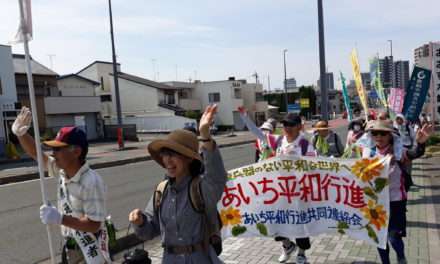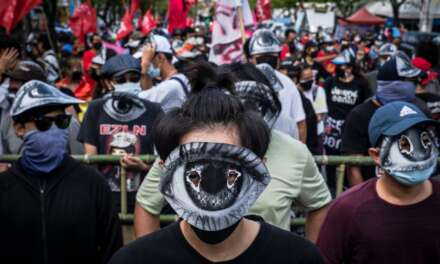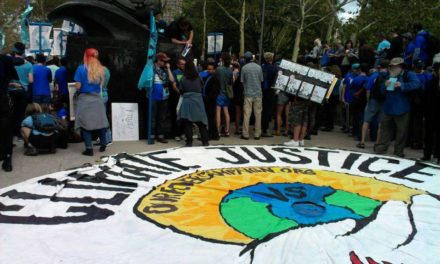Saturday 12 February: Last Monday, 7 February, the East Timorese newspaper Suara Timor Loro Sa’e reported that at least 53 people had died of starvation in the village of Hatabuiliko since October 2004. “There is absolutely nothing to eat,” reported Domingos de Araujo, the sub-district secretary, and “those still alive are looking for wild potatoes in the forest.”

Reports from the districts continue to filter in: 10,000 people are staving in Cova Lima; 10,000 households are going hungry in Suai; and Los Palos, Baucau, and Manufahi districts are all reporting a food crisis.
The government’s National Disaster Management Office has quickly counseled against overreaction because this is not “starvation and hunger like in Somalia, Ethiopia, Sudan and elsewhere.” Instead, what is happening “is known as FOOD SHORTAGE” (their capitalisation) and this “happens every year”.And there lies the deeper tragedy: this is not extraordinary news. Regardless of whatever definition the government is playing around with, hunger is so common in East Timor that November to March is referred to as the “hungry season”. Last year, food aid was distributed to 110,000 people in eleven out of the country’s thirteen districts and in a 2001 survey, 80 per cent of villages reported being without adequate food at some time during the year.
While a tough drought shares some of the blame, the question that screams to be asked is why is a nation of just under one million people, which is supposed to have received more donor funds “per capita” in the last five years than anywhere else, starving?
THE MORE THINGS CHANGE…
Since the independence referendum of 1999, an estimated $3 billion in aid money has been swirling around board rooms, Dili’s expensive foreign restaurants and the US dollar bank accounts of international consultants, rarely making the desperately needed trip beyond the city limits of the national capital. In one government department, a single international consultant earns in one month the same as his 20 Timorese colleagues earn together in an entire year. Another consultant charged the UNDP $8,000 for his first class airfare from his island tax haven. And these stories add up. A recent European Commission evaluation of the World Bank managed Trust Fund for East Timor noted that one third of the allocated funds were eaten up in consultant fees, to say nothing of overheads and tied procurements. But the problem is far deeper than the financial waste of the aid industry.
 Dili’s development elites no doubt blame the past. To be sure, the departing Indonesian military destroyed 70 per cent of the infrastructure and displaced two-thirds of the population during their bloody exit in 1999. Indeed, since the Portuguese first landed on the tiny island almost 500 years ago, the Timorese struggle to overcome hunger and to control their systems of food production has been intimately tied up with their struggle against foreign occupiers.
Dili’s development elites no doubt blame the past. To be sure, the departing Indonesian military destroyed 70 per cent of the infrastructure and displaced two-thirds of the population during their bloody exit in 1999. Indeed, since the Portuguese first landed on the tiny island almost 500 years ago, the Timorese struggle to overcome hunger and to control their systems of food production has been intimately tied up with their struggle against foreign occupiers.
For the farmers of Hatabuiliko and some 40,000 families across the mountain provinces, coffee is the symbol of this struggle. The Portuguese expanded the industry in the 1800s with the usual brutal colonial formula of land dispossession, forced labour and cultivation. The Indonesian military took over the industry in 1976 with such ruinous exploitation that coffee farmers were effectively forced to fund their own genocide. This left the sector in a state that Timor’s Planning Commission described in 2002 as “non-viable”.
Since the independence vote in 1999, the donor-prescribed dismantling of state supports for the industry, combined with an oversupplied and deregulated global coffee market, has consigned farmers to misery. Coffee, the nation’s flagship export, earned a dismal $5 million in 2003 (total exports were only $6 million), the result of prices a mere 19 per cent of their 1980 value and in 2002, the lowest ever in real terms.
FREE TIMOR, FREE MARKET
Under the larger donor blueprint of Timor’s reconstruction, the market has been radically liberalised, all state support has been curtailed, and the government cut in half, restricted to 17,000 staff under World Bank-IMF-imposed macro-economic conditionalities and a miserly national budget of $75 million. There’s no need for big government, according to the development elite, when the State should stick to being a cheerleader for a “dynamic private sector” riding high on an export-led economy fuelled by foreign direct investment.
Last year I spoke with a group of rice farmers in Bobonaro district about how they were faring in this brave new globalised world. They lamented that imported rice from Thailand and Vietnam – now making up 55 per cent of domestic consumption – undercuts anything they can produce. While the former Indonesian occupiers invested heavily in infrastructure, subsidised basic commodities and farm inputs, and provided a guaranteed floor price for farmers, the new occupiers have scrapped all of that. These days, farmers visit their World Bank designed and privatised Agricultural Support Centre, to purchase farm inputs at prices so high it pushes their production costs of production above the selling price of rice.
With rural life a struggle, Timorese have flocked to Dili looking for jobs. In July last year, I visited Domingos Frietas, an old friend bringing up a family of five in a squatted house in Dili. Scratching around for more work, his monthly part-time teaching salary of $50 just isn’t enough. A dollarised and liberalised economy, combined with the inflationary spending of the aid invasion, has dragged up the price of living beyond the average Timorese wage. Rice alone is $15 for a sack that lasts the month. Malnutrition levels in the capital are among the highest in the country.
“Electricity is so expensive, about $15 a month, if we could pay”, says Domingos. It’s a massive increase on the couple of dollars charged under the Indonesians. Most cannot and will not pay the tariff under the new user-pays and partly privatised system.
Prime Minister Alkatiri is asking people not to “politicise” the food crisis, advice bravely ignored by Abilio dos Santos, a government disaster management official, who pointed the finger at his employer: “Timor-Leste government has neglected the starvation.” He’s right, in some ways. For this financial year, the Fretilin government budgeted just US $1.5 million for the Ministry of Agriculture, a pitiful amount considering 85 per cent of the nation relies on agriculture for their largely subsistence livelihood.
This is a radical departure from 1975 when the same party protested against famine with anti-colonial defiance: “We are a nation of farmers but still our people go hungry?” Thirty years later, the question is still asked but instead of revolutionary songs, Fretilin is forced to sing the donor’s tune. And if they don’t? “Put bluntly,” opines a leaked US Congress memo on activities in Timor, “it seems likely that assistance levels will decline if East Timor’s government pursues economic or budgetary policies which were unacceptable to donors.”
Like the Indonesians and Portuguese before them, East Timor’s donors dictate policy in agriculture. “Most donor assistance is focused on the rice sector,” says Ego Lemos, spokesperson for the sustainable agriculture organisation HASATIL. For example, an estimated US $18 million of donor funds will have been spent on rehabilitating irrigation schemes from 1999 to 2006. But increases in rice production have been modest. Few farmers are planting a second crop in land that is dry, with intense floods that bring irrigation destroying sediments. In fact rice was never a key staple in Timor and it was only under the Indonesian occupation that production expanded. “During these 24 years we must eat rice,” says Ego, who bemoans that international donors have continued this trend, neglecting more appropriate upland crops such as maize.
And what of the donor-prophesised arrival of foreign direct investment and the private sector?
“(With) start-up costs 30 per cent higher and operating costs, 50 per cent higher than the rest of the region, there aren’t too many areas for investment in this country,” said one government investment adviser I quizzed. One local chicken factory near Dili was forced to shut down because imported chickens are only half the price of the local product.
“THEY’RE NOT AMBITIOUS ENOUGH”
Meanwhile, the economy is steadily contracting and unemployment is skyrocketing with 15,000 people entering the workforce each year. Even the IMF conceded at the last donors’ meeting that these pressures are “reinforcing widespread poverty and serious underemployment”. The deepening crisis of Asia’s poorest country should be apparent to all. Indeed, donors have been wondering why Timorese farmers and workers aren’t blossoming into productive micro-capitalists, like the textbooks tell them.
Local wages are too high, says the IMF in their latest report, praising the government for resisting “the introduction of populist measures” like a minimum wage. (The World Bank led by example, forcing Chubb security to cut the salaries of the Bank’s security guards from $134 to $88 per month.)
They’re not ambitious enough, says one donor commissioned trade report, recommending the engagement of an institute to teach Timor’s “low income youngsters entrepreneurship”.
They should forget about their rice and chickens, and diversify into “market dynamic commodities”, counsels USAID and the World Bank. But for Ego, this logic sidesteps reality.
“Every farmer has to grow cash crops, for example, vanilla, coffee and so on, under this policy, but this is not looking at the question, ‘do people have enough to eat?’,” says Ego. Even if a handful of farmers can produce niche commodities for fickle Western consumers, the rest of the country will continue to suffer or simply disappear like the 53 men, women and children of Hatabuiliko. Under the free market, Timor is just a tiny half island of surplus humanity.
Is it so offensive for a nation as poor as Timor to be allowed to instead adopt policies which support and protect 85 per cent of the population? To heal Timor’s deep colonial scars, “the government should subsidise the rural poor by investing in basic infrastructure,” says Maria “Lita” Sarmento from the local land reform and conflict resolution organisation Kdadalak Sulimutuk Institute (KSI) (meaning “streams come together”). “We don’t need expensive technology; we just need to support our traditional systems,” she says.
Ego buzzes with alternative ideas for agriculture, many of them inspired by the annual farmer-organised agricultural fair “Expo Popular”.
“We need to block imports of food that we can produce here,” argues Ego. But won’t your people starve? “This argument is nonsense,” responds Ego. “We have the means to feed ourselves but we need the right policies and the right assistance. In times of crisis, people are relying on yams, taro, banana, jackfruit, and so on. We need to develop our natural food sources, not to develop a dependence on food aid, and the hybrid seeds and chemical fertilizers they dump on us.”
The tragedy of the famine in Timor is that the will to provide the humble assistance Ego and Lita speak of – to say nothing of the years of struggle and international solidarity – has been debased into the World Bank’s policy architecture. The other barrier is the Australian government which is laying claim to $30 billion of the $38 billion of gas and oil resources in the Timor Sea. This is famine-preventing revenue that belongs to East Timor under International Law.
Yet the work of Timorese like Lita and Ego show that the independence movement is starting to paint new slogans on their old banners: to push the idea of sovereignty beyond the parliament buildings and out into the fields and forests, as Timorese attempt to regain control over their systems of food production.
Hatabuiliko is perched at the foot of the summit of Mt Ramelau, the tallest mountain in East Timor. From the top you can nearly see all of this small and beautiful island: a spine of mountains barely 90 kilometres wide, splitting the ocean like a wedge. Since October, people have being dying in this village, barely 100 kilometres of winding mountain roads away from the capital. Since October, dozens of the aid industry elite have passed through the village on their tourist pilgrimage before parking their four wheel drives on the other side to begin the ascent. Many would have hired a guide from Hatabuiliko. So why didn’t any of them notice? Is the disconnection between donors and Timorese reality so complete that those dying of hunger become an unremarkable part of the landscape?
Last year I spent one cold night in the church at Hatabuiliko. I don’t know who of the people I shared a meal and a few happy hours with have died. Those who remain must be asking why their nightmare continues.
* Ben Moxham works as a researcher for Focus on the Global South (www.focusweb.org).









